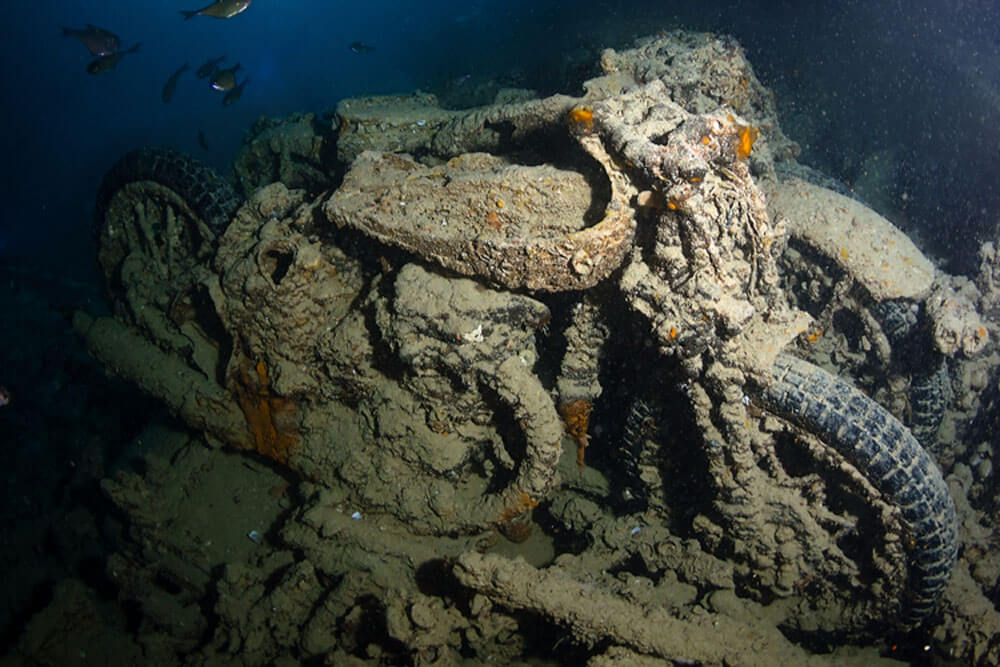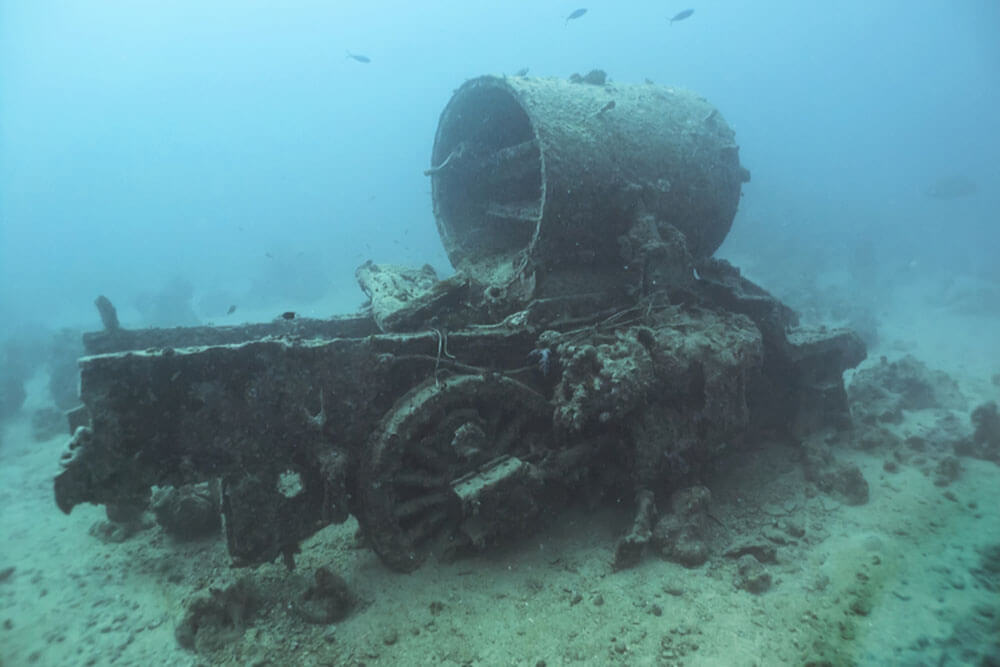Everything you need to know about the world’s most popular wreck dive

1) The Thistlegorm lies at 30m at 27 48.800 N / 33 55.25.
2) She was built by Joseph L Thompson & Sons in Sunderland.
3) She cost £115,000.
4) Gorm is Gaelic for blue.
5) She was owned by the Albyn Line, founded in 1901 by William Black and Walter B Allan.
6) She was christened by Mrs K W Black and launched on 9 April, 1940.

7) The Albyn line named all of their ships after the thistle, the national flower of Scotland.
8) Between 1901 and 1960 the Albyn Line owned 18 ‘thistle’ ships, from the first Thistledhu, the black thistle, to the last, Thistleroy, or red thistle, the second of her name.
9) The Thistle ships built by J L Thompson & Sons include the contemporary Thistelbrae (1928), Thistlegorm (1940), Thistledale (1941) and Thistlemuir (1941), plus the later Thistledowne (1952) and the second Thistelroy (1960).
10) The SS Thistlegorm weighted 4,900 tonnes and could comfortably reach a speed of 10 knots.
11) The ship was part of a convoy of 16 ships heading to Alexandria resupplying the British 8th Army at Tobruk.
12) Recent studies suggest she was mainly carrying supplies for the RAF and probably had enough to set up a whole airfield.
13) The SS Thistlegorm was classified as an armed freighter.
14) According to admiralty record AFO 1524/41 she was armed with a 3-inch light anti-aircraft gun and a 4-inch cannon (from the First World War) bolted onto the stern of the ship.
15) The cannon was reportedly test-fired only once and one anecdotal report jokes that it was probably safer to stand in front of the barrel rather than sit in the gunner’s seat.

16) Thistlegorm was sunk during a surprise attack by a pair of Heinkel He-111 bombers dispatched from Kampfgeschwader (flight squadron) KG26 in Crete.
17) The bombers were originally ordered to search for, and sink, the RMS Queen Mary, a royal cruise liner converted into a troop ship.
18) The Queen Mary, carrying 1,500 Australian troops, escaped unscathed.
19) This was Thistlegorm’s fourth voyage since her launch. The first was to the US to collect steel rails and aircraft parts, the second to Argentina for grain, and the third to the West Indies for rum.
20) The convoy was halted at Sha’ab Ali (Safe Anchorage F) because a tanker had run a German mine at the entrance to the Suez canal, and the convoy had to wait until the wreckage was cleared.
21) The Heinkels were one of the most technically advanced planes of the day.
22) They carried 2.5 tonne high explosive bombs.
23) They were heading back to base in Crete as they were running low on fuel when they came across the convoy by accident.

24) Eye witnesses said the bombers flew so low over the convoy that if their undercarriage had been lowered they would have hit SS Thistlegorm’s superstructure.
25) It is thought two bombs were released, but there is some uncertainty as to whether both struck the ship.
26) HMS Carlisle was struck by shrapnel from the blast.
27) At least one of the bombs hit Hold #4 just aft of the bridge at 01.30 on 6 October.
28) Ammunition stored in the hold also exploded resulting in the ship going down at 01.39.
29) The Thistlegorm is a war grave and must be dived with respect!
30) Four sailors and five members of the Royal Navy gun crew died in the blast.
31) The survivors were picked up by HMS Carlisle.

32) Captain William Ellis was awarded the OBE for his actions following the explosion.
33) Crew member Angus McLeavy was awarded the George Cross for his bravery in rescuing an injured Navy gunner. He ran barefoot through the fire and across the red hot steel deck to save his compatriot.
34) He said after the attack: ’I made for the side to jump overboard and the rail was almost red-hot under my hand. I don’t know why, but, just as I was going to jump, I looked back and saw the gunner crawling along the deck on the other side. The deck was covered with broken glass and I had to take the bits out of my feet before I could carry the gunner through the flames, which came up to my chest in places.’
35) John Whitham, another of the crew, said at the time: ‘I was on watch at twelve o’clock and about one o’clock we heard the sound of aircraft. We looked across to the Carlisle and there was nothing indicating from her and the sound of the aircraft got nearer and the first thing that we realised was that he was planting a few bombs on us, which, unfortunately, dropped in number four hold, possible number five, but number four I do know, because there was some flames shooting out from there and we……we’d quite a good fire going for a while.’

36) The Rosalie Moller – another great Red Sea wreck – was sunk three days after the Thistlegorm a few miles away.
37) One of the Heinkels was shot down by a convoy gunner after the initial attack.
38) The two crew members were captured and spent the rest of the war as POWs in Australia.
39) The steam locomotives from the deck cargo which were blown off 30m to either side of the wreck.
40) She was first ‘discovered’ in 1955 by Jacques-Yves Cousteau. It’s likely that he asked local fishermen where the wreck was – they regularly tied up to the mast which at the time showed clear of the water.
41) It is believed Cousteau chopped down the mast so others would not be able to find the wreck.
42) The Thistlegorm was featured in Cousteau’s 1956 documentary The Silent World, and in a 1956 edition of National Geographic magazine.
43) The report in the National Geographic clearly shows the ship’s bell in place.
44) Dr Adel Taher, the founder of Sharm’s Hyperbaric Medical Centre, ‘rediscovered’ the wreck in the early 1990s with three friends and dived it in secret for two years before others discovered its whereabouts.
45) Most of the cargo remained on board – although medical supplies disappeared.

46) It was reported that morphine from the wreck could be bought in Cairo street markets years after the attack.
47) Of all the trucks that the Thistlegorm was carrying, only two still have their steering wheels. No, we’re not telling you where they are.
48) Birmingham Small Arms (BSA) produced some of the famous motorcycles found on the wreck, and also the Lee Enfield .303 carbines found in Hold # 1
49) The UC-MkII tanks were also known as ‘bren gun carriers’, after the modified Czech machine gun they carried.
50) The fuses for the large ammunition were stored separately. The shells won’t spontaneously explode, but it’s probably better not to hit them too hard.
51) It isn’t true that all the Wellington boots are left footers – some right foot boots have been found.

52) The LMS Stanier class 8 F steam locomotives weighed 72 metric tonnes apiece – 126 tonnes if you include the coal tenders and water waggons.
53) The wings in the forward hold are for Westland Lysanders.
54) What are often mistaken for motorbike sidecars are, in fact, undercarriage housings for the Lysanders and RAF accumulator trolleys used for powering up aircraft.
55) There were more than 100 motorbikes aboard the Thistlegorm.
56) On the lower levels are Nortons and on the upper, the BSA bikes.
57) The Nortons in the lower level of Hold #2 are loaded onto Fordson War Office Transport trucks.
58) For years the wreck was looted and items regularly turned up on Ebay – everything from complete motorbikes to ammunition was taken.
59) In 2007 the Hurghada Environmental Protection and Conservation Association (HEPCA) installed 32 permanent mooring buoys.
60) At the same time they drilled holes in the wreck to allow trapped air to escape.
61) By 2009, none of the moorings was still in place – the blocks were too light (resulting in ships dragging them), and the lines connecting the moorings to the wreck were too long (making it difficult for divers in strong currents to reach the wreck).
62) Today all dive boats moor off directly to the wreck.
63) As many as 35 dive boats have been recorded at the site at one time.
64) The biggest threat to the Thistlegorm is the use of steel hawsers to secure mooring lines to the wreck. Unlike ropes, they cut through the superstructure as they rub against it in the surge.
65) Reputable dive centres insist that you have at least 20 dives and carry the equivalent of a PADI Advanced qualification before allowing you to dive the Thistlegorm.
66) The deck level of the wreck is at about 17m.
67) Tuna, barracuda, batfish, moral eels, lionfish, scorpionfish and turtles are all regularly seen on and around the wreck.
68) The unofficial but nevertheless accepted method of diving the Thistlegorm, both inside and outside, is in an anti-clockwise direction.
69) Rumour has it that the captain of the Thistlegorm was NOT the last person to use the lavatory in the captain’s cabin.

70) There’s a ‘missing piece’ of the superstructure. It took some technical divers several months to find but many dive guides who have safety stopped alone in a strong current will know exactly where it is.
71) The captain’s bathtub is famous, but not so many people know that there is also a bathtub on the bridge. Why is there a bathtub in the bridge? ‘Full steam ahead and where’s my rubber ducky!’
72) The stern section should be tackled as a separate dive. You can see one of the locomotives blown off the decks in the blast and you can also check out the large prop.
73) There is a campaign to preserve the wreck – see http://www.savessthistlegorm.com/
74) The Thistlegorm is one of the most dived wrecks in the world.
75) It is estimated that more than one million people have dived the Thistlegorm. It has also been calculated that the wreck has generated more than $100 million in tourist spend in Egypt!


